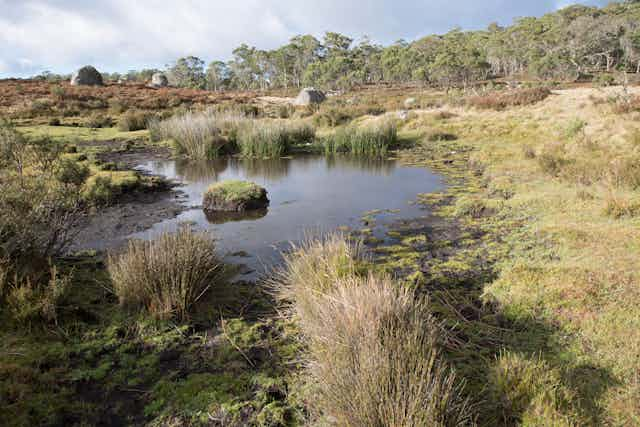Prime Minister Malcolm Turnbull’s plan for a A$2 billion upgrade and expansion of the Snowy Mountains Hydroelectric Scheme, announced last week, will be an impressive engineering achievement. Snowy Hydro 2.0 will increase the scheme’s capacity by 50%.
Meeting this extra capacity will depend entirely on the natural water supply available in the Snowy Mountains. But the current environmental conditions of these mountains, and the Australian Alps where they are located, are compromising both water delivery and water quality.
The only way to maintain water flow is to control the threats that are actively degrading the high country catchments. These include introduced animals, wetland loss, and climate change.
Restoration and management
The remarkable Snowy Hydro Scheme was developed over 25 years from the 1940s. During this period the NSW Soil Conservation Service and later NSW National Parks effectively managed soil and restored areas damaged by grazing.
Conservation efforts focused on looking after topsoil, stabilising wetlands, and restoring vegetation after decades of grazing. This ensured good amounts of high-quality water for both hydro power and irrigation downstream.
More recent efforts have focused on the impacts of building the original Snowy scheme. This includes restoring areas cleared for roads and construction sites, and areas where rock and soil from blasting and cutting were dumped.

Threats to mountain catchments
The Australian Alps are the nation’s water towers. They provide water for growing food and hydroelectricity, but face several threats.
Across the Alps, despite well-informed and committed control programs, feral horses, pigs and deer are destroying wetlands, degrading streamside vegetation, and causing moisture-holding peat soils and stream channels to erode. This leads to more evaporation, more rapid runoff and erosion, less water flow, and lower water quality.
There is currently no effective response to this damage. We estimate that more than 35% of the high mountains’ wetlands have been affected, and the problem is getting worse.
The Alps are also recognised as extremely vulnerable to climate change. Climate models suggest that alpine areas that currently receive at least 60 days of snow cover will shrink by 18-60% by 2020.
Temperatures in the alps are already increasing by 0.4°C per decade, an increase of 1.79°C since records began. Climate change projections for the Australian Alps indicate the hottest summer days will be around 5°C warmer in 2100, minimum temperatures will rise by 3-6°C, and precipitation (rain and snow) will decrease by up to 20%, with less falling as snow. These changes are already putting pressure on iconic mountain ecosystems including the peatlands, snowgum woodlands and alpine ash forests.
The Australian Alps are also likely to experience more extreme events such as heatwaves, storms, fires and severe frosts. All of these affect high mountain ecosystems, making the environment more vulnerable to disturbances such as more fires, weeds and disease outbreaks.
For example, the root-rot fungus, Phytophora cambivora, recently appeared in the alps. The fungus killed large areas of shrubs following unusually warm springtime soil temperatures.
New weeds are an additional concern for the alps as these may compromise the existing plant communities and their ability to deliver services such as water. Alpine peat soils, which build up over thousands of years, can also burn in drought.
Reliable water depends on functioning ecosystems
A stable water supply from the Alps is crucial for energy and food production. This relies on intact vegetation.
Back in the 1950s, it became clear to the researchers at the Soil Conservation Service that hard-hooved animals, in this case domestic cattle, were severely damaging the alpine catchments.
The success of the original Snowy scheme depended on removing cattle from alpine areas, controlling soil erosion that resulted from prior grazing and hydro works, and carrying out extensive revegetation works across the whole of the nearby mountain ranges.
However, land managers to this day are still controlling a legacy of disturbance and weed invasions from both the Snowy scheme itself and years of previous grazing. Snowy 2.0 must consider these lessons from the past, and work to improve mountain catchments.
Alpine plants and animals often live close to their environmental tolerances, meaning they are not necessarily able to cope with change. For some species, climate change is likely to exceed these thresholds. Vegetation communities will change as current populations decline and colonisers from different species move in to occupy the gaps, including invasive species.
Feral horses make it even more difficult for native species to respond to a changing climate, by exacerbating environmental degradation and impacts on water.
Part of the solution is restoring and re-vegetating degraded high country landscapes. For example, restoring snowgum communities, which were severely affected by burning and grazing, may lead to increases in the amount of water trapped as drifting fog.
But climate change will demand new research and management partnerships to find species that will survive well into the future and to develop adaptation pathways to respond to uncertain conditions.
This will be a new and different world. We are currently ill-prepared to maintain high-quality water yield in the future, to predict the impacts of climate change, or to effectively protect our alps for future generations.
But we are confident these questions can be answered with adequate investment in the environmental infrastructure needed to underpin the engineering. We estimate that between A$5 million and A$7 million per year is needed to research and develop new management structures. You could see this investment as royalties returned to the system that provides the water and power.
Turnbull’s plan may deliver more power, but only if the environment is carefully managed. Otherwise Snowy Hydro 2.0 may be left high and dry.

